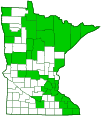creeping juniper
(Juniperus horizontalis)
Conservation • Wetland • Description • Habitat • Ecology • Use • Distribution • Taxonomy
Description |
||
Creeping juniper is a low, fast-growing, short-lived, evergreen, perennial shrub. It often forms large, dense, sometimes mat-like clones. The stems lay flat on the ground (prostrate), sometimes with the tips curved upward (decumbent). They may be 4′ to 8′ long, up to ¾″ in diameter, and 4″ to 12″ in height. They often root at the nodes and then detach, forming a new plant, a process known as layering. The bark is reddish-brown and thin at first, eventually peeling in thin strips. On larger branches it peels in wide strips or plates. The branches are slender, upright, 3- or 4-sided in cross section, and hairless. In the first year they are green and are tightly wrapped with overlapping, awl-shaped scales. The scales turn reddish-brown in the first winter and remain of the branch for 2 to 5 years. The leaves are opposite and evergreen, persisting 4 to 5 years. They are green but turn reddish-purple in the winter. There are two types of leaves, juvenile whip leaves and adult scale-like leaves. Whip leaves are awl-shaped to needle-like and spread away from the stem. They are ⅛″ to ¼″ long, 1 ⁄64″to 1 ⁄32″ wide, and are sharply pointed at the tip. They are not jointed at the base but merge smoothly with the stem. The margins are untoothed. Adult leaves are egg-shaped, are tightly appressed to the stem, and overlap for ⅓ of their length. They are 1 ⁄32″ to ⅛″ long, 1 ⁄64″to 1 ⁄16″ wide, and are rounded or broadly pointed at the tip, with an abrupt, small, slender point at the tip. The margins are untoothed. Numerous male (pollen) and female (seed) cones are borne on separate plants. The male cone is yellowish-brown, ellipse-shaped to oblong, and 1 ⁄16″ to ⅛″ long. It is stalkless and is are borne at the end of a second-year branch. It is composed of 6 to 10 cone scales. It releases pollen in late April to late May. The mature female cone is fleshy, berry-like, egg-shaped to globe-shaped, and 3 ⁄16″to 5 ⁄16″ in diameter. It is on a curved, scaly, 1 ⁄16″ to ⅛″ long stalk and is borne at the end of a second-year branch. It is green at first, becoming bluish-black and covered with a bluish-white, waxy coating (glaucous) as it ripens. It matures in the second year. |
||
Height |
||
Up to 12″ |
||
Similar Species |
||
Common juniper (Juniperus communis var. depressa) is usually at least 3′ tall. It has only needle-like leaves, no scale-like leaves. Eastern redcedar (Juniperus virginiana var. virginiana) is a tree. The female cones are on straight stalks. It is otherwise indistinguishable in appearance. |
||
Habitat |
||
Dry. Prairies, sand barrens, sand dunes, rock outcrops, stream banks. Full sun. Sandy or gravelly soil. |
||
Ecology |
||
Pollination |
||
|
||
Pests and Diseases |
||
|
||
Use |
||
|
||
Distribution |
||||
|
Sources |
|||
| 3/28/2023 | ||||
Nativity |
||||
Native |
||||
Occurrence |
||||
Uncommon and localized in Minnesota |
||||
Taxonomy |
|||
| Kingdom | Plantae (Plants) | ||
| Subkingdom | Pteridobiotina | ||
| Phylum | Tracheophyta (Vascular Plants) | ||
| Class | Pinopsida (conifers) | ||
| Subclass | Pinidae | ||
Order |
Pinales (conifers) | ||
Family |
Cupressaceae (cypress) | ||
Subfamily |
Cupressoideae (cypresses, cedars, junipers, and allies) | ||
Genus |
Juniperus (junipers) | ||
Section |
Sabina (scale-leaf junipers) | ||
| Subsection | Juniperus | ||
Subordinate Taxa |
|||
|
|||
Synonyms |
|||
Juniperus horizontalis var. douglasii Juniperus horizontalis var. glauca Juniperus horizontalis var. variegata Juniperus hudsonica Juniperus prostrata Juniperus repens Juniperus virginiana var. prostrata Sabina horizontalis Sabina prostrata |
|||
Common Names |
|||
American savin creeping juniper creeping savin juniper creeping-cedar prostrate juniper shrubby red-cedar trailing juniper Waukegan juniper |
|||
Glossary
Decumbent
Reclining on the ground but with the tips ascending.
Glaucous
Pale green or bluish gray due to a whitish, powdery or waxy film, as on a plum or a grape.
Layering
A method of propagation where a stem or branch comes into permanent contact with the soil, sprouts roots, and then detaches from the main plant.
Prostrate
Laying flat on the ground.
Visitor Photos |
|||||
Share your photo of this plant. |
|||||
| This button not working for you? Simply email us at info@MinnesotaSeasons.com. Attach one or more photos and, if you like, a caption. |
|||||
|
|||||
MinnesotaSeasons.com Photos |
|||||
Plant |
|||||
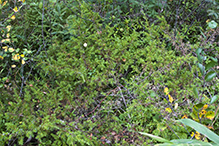 |
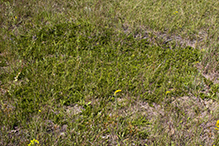 |
||||
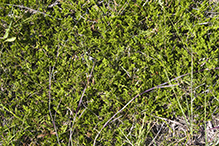 |
|||||
Female Seed Cones |
|||||
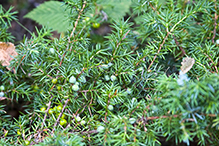 |
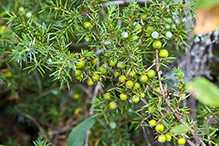 |
||||
Immature, Awl-shaped Leaves |
|||||
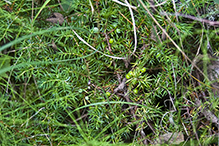 |
|||||
Mature, Scale-like Leaves |
|||||
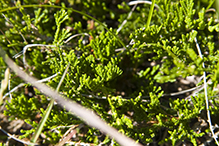 |
|||||

Slideshows |
||

Visitor Videos |
|||
Share your video of this plant. |
|||
| This button not working for you? Simply email us at info@MinnesotaSeasons.com. Attach a video, a YouTube link, or a cloud storage link. |
|||
Other Videos |
|||

Visitor Sightings |
|||||
Report a sighting of this plant. |
|||||
| This button not working for you? Simply email us at info@MinnesotaSeasons.com. Be sure to include a location. |
|||||
| William Olson 5/10/2013 |
Hi Info, |
||||
MinnesotaSeasons.com Sightings |
|||||

|
Created: Last Updated: © MinnesotaSeasons.com. All rights reserved. |
